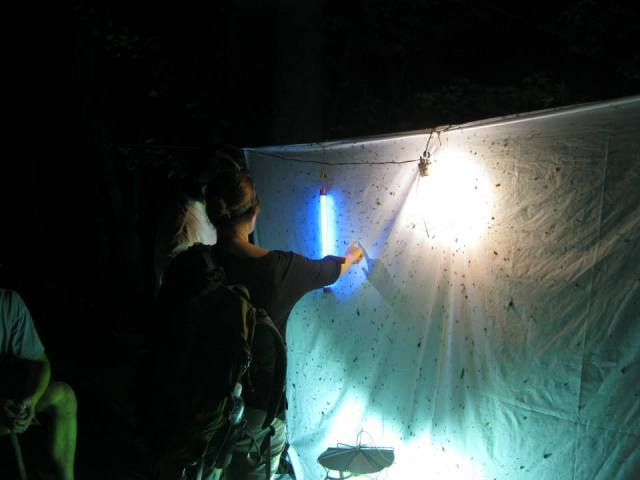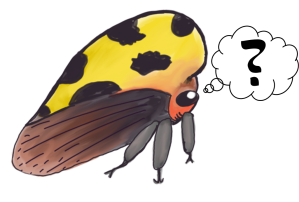Written by Joe Ballenger
@BugQuestions Nothing in particular, it is just you provide helpful advise prior to them attacking me (trying to get to my floodlight).. 😛
— intrepid wanders (@intrepidwanders) May 28, 2015
Since it’s June, I’ve been getting a lot of questions here and at work about June Beetles. They’re really common, show up about this kind of year and just kind of hang out on porches. I think of them a little bit like the summer version of Christmas decorations , but they’re small, brown and, well…constantly engaging in X-rated activities.
So what are these things, why do they get on your porch, and how do you get them to stop doing that?
What, exactly, are June Beetles?
June Beetles are Scarab beetles which appear in large numbers at this time of year. There are two general types-big and small for now-which seem to suddenly appear about now and then vanish about a month later. Both are from really big groups which consist of a couple hundred species apiece.

Cyclocephala sp, also known as the Masked Chafer, is one of the more common June Beetles.
Picture courtesy of K Schneider via Flikr
License info: CC-BY-NC 2.0
The small ones are from the genus Cyclocephala, also known as masked chafers. As larvae they’re lawn pests known as ‘white grubs’ and commonly feed on grass roots and thatch near the surface of the soil. They take two years to grow from egg to adult, so those beetles you see every year are actually about toddler-aged. The adults don’t feed, so if you suddenly see a lot of damage to flowers then it’s not these guys.

Phyllophaga sp, also known as the May Beetle is also one of the more common June Beetles.
Picture courtesy of Anita Gould via Flikr.
License info: CC-BY-NC 2.0
The big ones are from the genus Phyllophaga, and are sometimes called May Beetles depending on where you are. They’re about twice the size of the smaller Cyclocephala. They take about 3-4 years to grow to adults, so the ones you see on your porch are probably the same age as a preschooler. Like the masked chafers, these June Beetles feed on roots of plants and can cause damage to a wide variety of plants.
So why are they on my porch?
June beetles are attracted to lights, and you’re likely seeing both boys and girls down there. Females attract males and mate before they start flying, although…we’ll just call them overly enthusiastic…males may mate with them again if the opportunity strikes.
A lot of insects get disoriented by light at night. They go towards the one thing they can see which is a big, blinding ball of light. This is really useful to us as entomologists, because it allows us to reliably catch a lot of insects. To insects, however, it can be a fatal mistake. They get concentrated in one area, which makes them a boon for predators. The stress of being stranded and exposed during the day eventually ends up killing them.

Entomologists checking out the black light at the Jean Lafitte Bioblitz in March 2013.
Picture credit: Joe Ballenger
Fortunately, June Beetles are extremely common and they’re not in any danger of going extinct. Unfortunately, a lot of insects are susceptible to light pollution…which is another story altogether. It’s still worth mentioning, though.
How do I get them to stop coming to my porch?
This is where things can get a bit complicated. June Beetles, both types, are lawn pests and spend most of their lives under your grass. If you take care of your lawn, you’re already lowering the population by controlling lawn grubs. There’s all sorts of stuff which is designed to kill white grubs, and those are the babies of June Beetles. So taking care of your lawn will keep their populations down.

Insects can’t see very well in the yellow-red spectrum, so a lot of porchlights glow with an orange light which doesn’t attract bugs. It won’t eliminate insects, but a white light will have a lot more bugs around it.
This porchlight is right outside of Joe’s apartment, and has a tragic lack of insects flocking to it.
However, there’s only so much you can do. If your neighbors aren’t as diligent as you, then they’re breeding these guys without realizing it. There are also all sorts of wild areas where these guys breed, since they have a huge range of plants they can eat. So, while you can control their numbers a little bit…there’s not a whole lot you can do by treating them yourself.
A much easier control method is to simply reduce the amount of insect attracting light around your house at night. If your front door has blinds, draw them and make sure they’re shut.
You can also get lights for your front porch which don’t attract insects. Many insects have difficulty seeing in the red-yellow part of the color spectrum, so you can buy lights which shine mostly in this spectrum. They’re only a couple dollars at your local Wal*Mart, and are well worth the money if you don’t want to sweep off your front porch at this time of year.
What if I…kind of like beetles?
Of course, if you want to attract some really cool bugs there are a lot of instructions online for building your own mercury vapor light set. Mercury vapor lights spit light light out which covers the widest amount of the light spectrum, and you can also build a UV light set for very cheap to augment this.

The supplies for this blacklight set can be obtained from Wal*Mart for less than $50. It works pretty well, but not nearly as well as a mercury vapor light.
They can be very pricey but if you’re willing to take the time and money to set it up, you’d be amazed at what you’ll find in your area.
Just…don’t forget to turn it off when you’re done. The bugs will really appreciate it. 🙂


What about the new LED lights in either white or “clear”? How wide a spectrum do they emit and how well do they attract insects?
LikeLike
Hey, Bob…
I’m not too sure what specific spectra household LED lights emit. Household lights tend to be either yellow or blue, because these are the colors people feel happiest being lit under…and there’s a whole host of research which goes into the spectra of household lights believe it or not. LED lights tend to be pretty specific in terms of what colors they emit, but I’m not sure exactly what colors they emit.
We’ll grab it for our question queue.
-Joe
LikeLike
The other day I noticed a handful of dead june bugs on my front porch and lined up at the foot of my door. I haven’t noticed any of this all summer and I never turn on my porch light and my front window has heavy curtains that we draw at night. Being curious I went to my back porch and found around 15 dead june bugs on the porch. We leave the screen door open since the glass door is closed and there are a bunch lined up inside the screen door dead that I don’t know how to get out. We also don’t use the back porch light though sometimes we have the kitchen light on. My question is why all of the sudden are there dead june bugs everywhere?
LikeLike
June bugs are attracted to light in general, and can even be attracted to indoor lights. These beetles tend to emerge en masse, which explains why they appear so suddenly.
So suddenly seeing a bunch trapped inside a screen door isn’t that unusual, especially during the summer. 🙂
-Joe
LikeLike
I think these beetles are grazing up all my spinach leaves and also the leaves of my young fruit trees. Can you help?
LikeLike
Unfortunately, there’s not a whole lot we can do. There are, however, a lot of products which are intended to treat gardens…but there’s often local usage restrictions.
The EPA runs a collaboration with Oregon State called the National Pesticide Information Center, which has a tool that can help you find a local expert.
It can sometimes take a bit of sleuthing, but they can point you in the direction of a local expert…and we’re glad to help walk you through the process if needed.
http://pi.ace.orst.edu/pals/
LikeLike